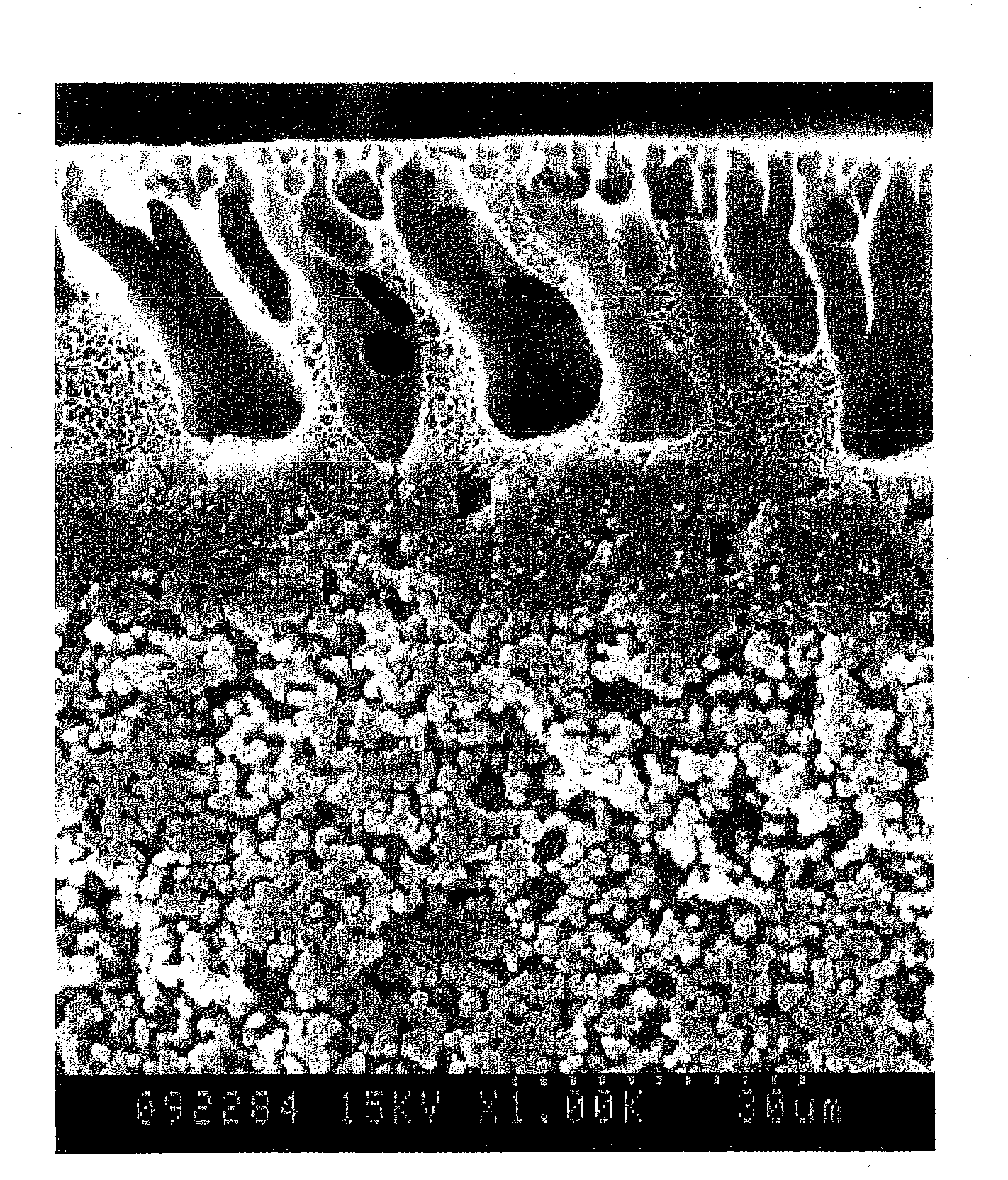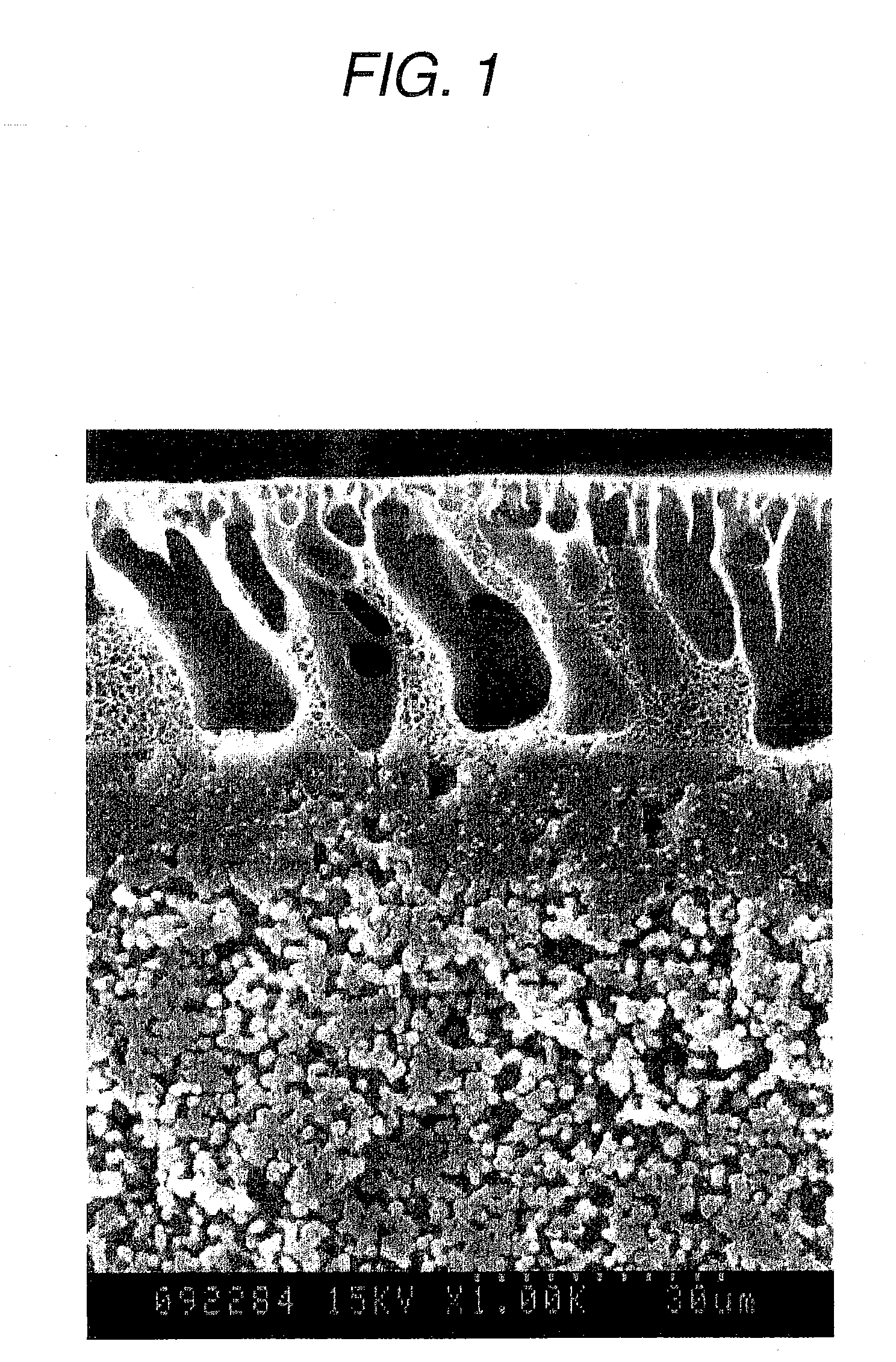Polymer separation membrane and process for producing the same
a technology of separation membrane and polymer, which is applied in the direction of water/sewage treatment, osmosis/dialysis, electrical equipment, etc., to achieve the effects of preventing fiber breakage or membrane fracture, preventing physical strength loss, and sufficient resistan
- Summary
- Abstract
- Description
- Claims
- Application Information
AI Technical Summary
Benefits of technology
Problems solved by technology
Method used
Image
Examples
example 1
[0121]A vinylidene fluoride homopolymer having a weight-average molecular weight of 417,000 and γ-butyrolactone were dissolved, in a proportion of 38 wt % and 62 wt % respectively, at 170° C. The obtained polymer solution was discharged from a die, accompanied by γ-butyrolactone as a hollow part forming liquid, and solidified in a cooling bath formed by a 80 wt % aqueous solution of γ-butyrolactone of 20° C. to obtain a hollow fiber membrane constituted of a spherical structure.
[0122]Then a vinylidene fluoride homopolymer having a weight-average molecular weight of 284,000 by 14 wt %, cellulose acetate (cellulose triacetate CA435-75S, manufactured by Eastman Chemical Co.) by 1 wt %, N-methyl-2-pyrrolidone by 77 wt %, polyoxyethylene palm oil fatty acid sorbitan (Ionet T-20C, hereinafter represented as T-20C, manufactured by Sanyo Chemical Industries, Ltd.) by 5 wt % and water by 3 wt % were mixed and dissolved at 95° C. to obtain a polymer solution. This membrane forming liquid was ...
example 2
[0128]A hollow fiber membrane of a spherical structure was prepared in the same manner as in Example 1.
[0129]Then a vinylidene fluoride homopolymer having a weight-average molecular weight of 284,000 by 14 wt %, cellulose acetate propionate (CAP482-0.5, manufactured by Eastman Chemical Co.) by 1 wt %, N-methyl-2-pyrrolidone by 77 wt %, T-20C by 5 wt % and water by 3 wt % were mixed and dissolved at 95° C. to obtain a polymer solution. This membrane forming liquid was uniformly coated on the surface of the hollow fiber membrane of spherical structure, and was immediately solidified in a water bath to obtain a hollow fiber membrane bearing a layer of three-dimensional network structure on the layer of spherical structure.
[0130]The obtained hollow fiber membrane had an outer diameter of 1340 μm, an inner diameter of 780 μm, an average diameter in the spherical structure of 2.4 μm, an average pore diameter of 0.05 μm on the surface of the layer of three-dimensional network structure, an...
example 3
[0134]A hollow fiber membrane of a spherical structure was prepared in the same manner as in Example 1.
[0135]Then a vinylidene fluoride homopolymer having a weight-average molecular weight of 284,000 by 14 wt %, cellulose acetate butyrate (CAB551-0.2, manufactured by Eastman Chemical Co.) by 1 wt %, N-methyl-2-pyrrolidone by 77 wt %, T-20C by 5 wt % and water by 3 wt % were mixed and dissolved at 95° C. to obtain a polymer solution. This membrane forming liquid was uniformly coated on the surface of the hollow fiber membrane of spherical structure, and was immediately solidified in a water bath to obtain a hollow fiber membrane bearing a layer of three-dimensional network structure on the layer of spherical structure.
[0136]The obtained hollow fiber membrane had an outer diameter of 1340 μm, an inner diameter of 780 μm, an average diameter in the spherical structure of 2.8 μm, an average pore diameter of 0.06 μm on the surface of the layer of three-dimensional network structure, an a...
PUM
| Property | Measurement | Unit |
|---|---|---|
| diameter | aaaaa | aaaaa |
| pore size | aaaaa | aaaaa |
| fracture strength | aaaaa | aaaaa |
Abstract
Description
Claims
Application Information
 Login to View More
Login to View More - R&D
- Intellectual Property
- Life Sciences
- Materials
- Tech Scout
- Unparalleled Data Quality
- Higher Quality Content
- 60% Fewer Hallucinations
Browse by: Latest US Patents, China's latest patents, Technical Efficacy Thesaurus, Application Domain, Technology Topic, Popular Technical Reports.
© 2025 PatSnap. All rights reserved.Legal|Privacy policy|Modern Slavery Act Transparency Statement|Sitemap|About US| Contact US: help@patsnap.com



